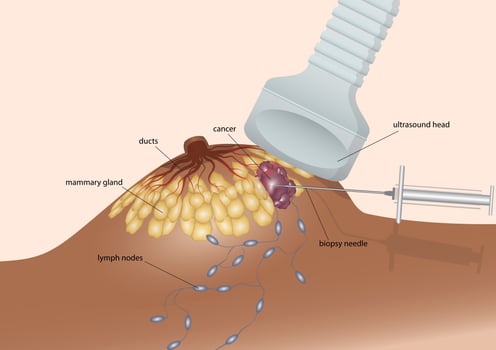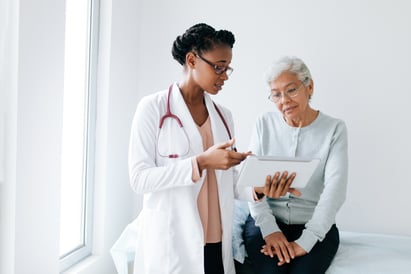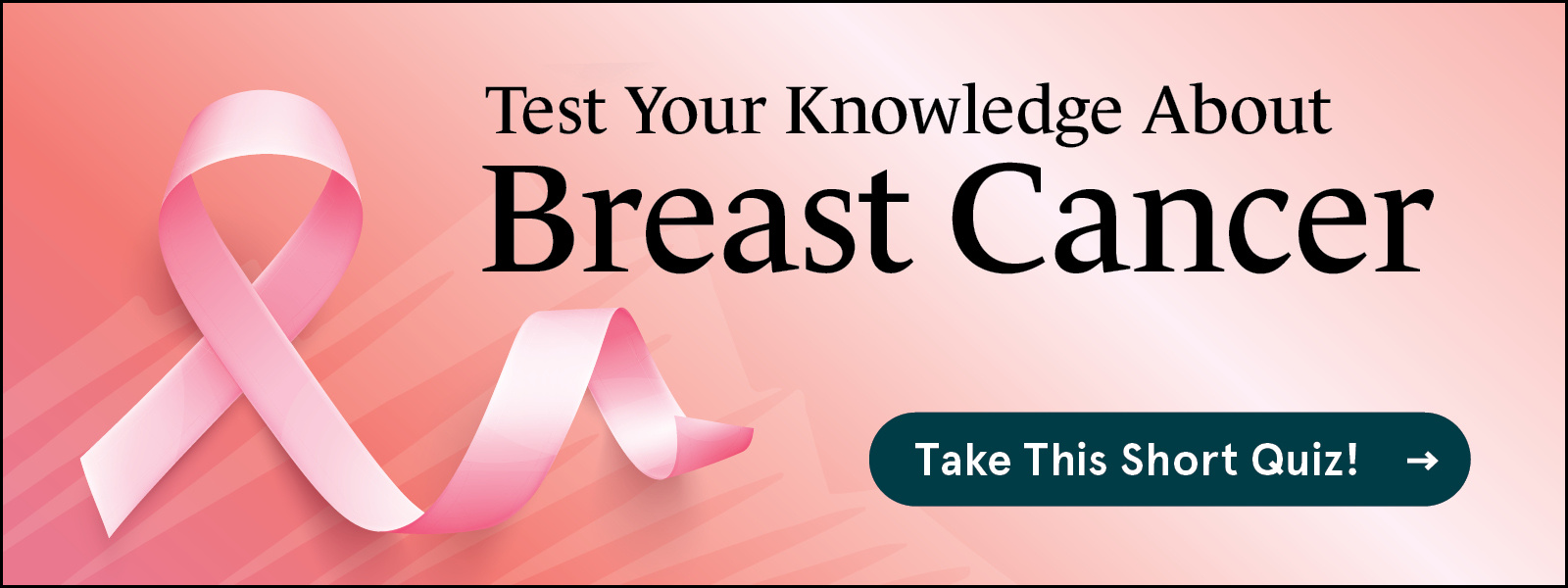Breast Biopsy: What to Expect if You Need One
6 min read

When you hear you need a breast biopsy, your thoughts can run wild.
“About 20% of the time, women will get a callback for additional imaging after a screening mammogram,” said Dr. Gerlinde Tynan, board-certified breast surgeon at Rocky Mountain Breast Specialists (RMBS). “And that can be very stress-provoking.”
It’s tempting to assume the worst, but Dr. Tynan said it helps to learn from reputable sources what a breast biopsy involves and cautions to stay away from the internet’s dark alleys.
“Do your best to wait until you get the biopsy results because most biopsies do not show breast cancer,” she said.
During a breast biopsy, a tiny sample of breast tissue is extracted and sent for specialized testing. If your doctor recommends a breast biopsy, it’s likely because there was a suspicious area noted on a breast mammogram, ultrasound, or MRI – and your healthcare team wants to investigate it thoroughly.
Before a Breast Biopsy
The first question many patients have about a breast biopsy is, will it hurt? Most patients describe the process as one that feels uncomfortable but not painful. Your comfort is a high priority, and your surgeon will take steps to alleviate pain.
To prepare for a breast biopsy, you will be asked to avoid pain relievers, such as aspirin and ibuprofen, and blood thinners for several days before your procedure. Tell your provider about any allergies or if you have had any adverse reactions to medications.
On the day of the procedure, leave your necklaces and earrings at home, skip applying deodorant, and bring or wear a supportive, wireless bra to your appointment. Plan for your breast biopsy to take a couple of hours, with most of that time devoted to preparation by your care team.
Types of Breast Biopsies
There are different types of breast biopsies, and your care team will recommend the one that is best for you. The main factors that determine which type of biopsy they recommend include the location and size of a breast lump or area of concern.
One type of breast biopsy is called a fine-needle aspiration. You will lay on an exam table, most likely on your back. If that position is not comfortable for you, your healthcare team will find alternatives. You will receive an injection of numbing medicine directly into the area, and you will remain awake. Next, a very thin needle is guided into the suspicious lump or area to extract a sample of breast tissue. Your doctor may find the lump is a fluid-filled cyst rather than a solid mass and may recommend further testing, if needed.
 A core needle biopsy involves a slightly larger, hollow needle to remove a sample of tissue from a breast lump. Sometimes, no cut or incision is made, as the samples are extracted through the core needle. As with a fine-needle aspiration biopsy, you will have a local anesthetic to prevent pain, and you will remain awake. Five to six small samples are removed and sent to the laboratory for evaluation.
A core needle biopsy involves a slightly larger, hollow needle to remove a sample of tissue from a breast lump. Sometimes, no cut or incision is made, as the samples are extracted through the core needle. As with a fine-needle aspiration biopsy, you will have a local anesthetic to prevent pain, and you will remain awake. Five to six small samples are removed and sent to the laboratory for evaluation.
Alongside these breast biopsies, your care team might use imaging tools to get a better visual of the area. Your breast biopsy procedure might be more specific, such as:
- A stereotactic breast biopsy, which involves using 3D mammogram technology to better show the area in question
- An ultrasound-guided biopsy, which involves a hand-held instrument called a transducer that your doctor uses for visual guidance
- An MRI-guided core needle biopsy, during which you’ll receive a contrast dye and have an MRI scan that uses magnetic waves to locate the area of concern
A surgical breast biopsy requires an incision. You will receive general anesthesia and be asleep during the procedure. With a surgical breast biopsy, a small cut is made, then a needle or probe is used to remove samples of suspicious tissue. Sometimes a radiologist is present during these procedures.
After a Breast Biopsy
After fine-needle and core-needle biopsies, you will have a bandage placed over the biopsy site. You may want to take it easy for the rest of the day. Side effects are usually minimal and easily managed. You should expect some bruising, which is a common side effect. Ice packs can be used to reduce swelling. Your team will tell you which over-the-counter pain relievers to use.
“Some ladies will go back to work,” Dr. Tynan said. “It’s not something you need to necessarily have the whole day off for.”
If you need a surgical breast biopsy, you can go home the same day but will need someone to drive you. You will have a small number of stitches at the incision site, so it’s important to follow your care team’s guidance to keep the area clean and healing properly.
Mild pain, swelling, and bruising are common after breast biopsies. Rarely, infection or bleeding occurs.
Depending on how much tissue is removed during your biopsy, your breast may look different after you have healed.
The Results of a Breast Biopsy
 “Typically, the results are back within a few days,” said Dr. Tynan, who added that patients will receive a call from the radiologist or the doctor who ordered the biopsy.
“Typically, the results are back within a few days,” said Dr. Tynan, who added that patients will receive a call from the radiologist or the doctor who ordered the biopsy.
The results of a breast biopsy are generally categorized as noncancerous (benign) and cancerous (malignant).
“Most biopsies do not show breast cancer,” Dr. Tynan said. In her clinical experience, only about 10% of breast biopsies come back positive for cancer.
Benign cysts are common, as are other types of noncancerous growths. After finding a benign result, the radiologist in charge will likely recommend a six-month to one-year follow-up to confirm the area has not changed. Learn more about non-cancerous breast conditions and their impact on your breast cancer risk.
If the result comes back as cancer, Dr. Tynan advises calm over panic.
“There are many different subtypes of breast cancer that can be different from one another,” she said. “One might be straightforward and very curable, and another might be very complicated. There is a high degree of technical information that comes with the biopsy reports, so a physician’s interpretation is necessary.”
Learn more about how to read the results of a breast biopsy in a pathology report.
There are also gray areas, such as the finding of a high-risk lesion.
“This may not be cancer, but it’s a biopsy result that indicates an increased risk of breast cancer,” Dr. Tynan said.
It’s possible to have a result classified as precancerous or something that shows a need for further investigation or screenings. If that happens, you will be referred to a breast specialist.
You could also have an inconclusive result.
“If that’s the case, then the radiologist will recommend that it be removed, and that’s when we get into that realm of having a surgical breast biopsy,” Dr. Tynan said.
Breast Biopsy Takeaways
The period of time before, during, and after a breast biopsy can be stressful for a variety of reasons. Bring a support person to your appointments if it helps. Journaling, meditation, walking, and other healthy activities can help keep you from overthinking. The key is to stay focused on what you can control – taking good care of yourself physically, mentally, and emotionally.
There’s a lot to learn about the testing, prevention, and treatment of breast cancer. Learn more about how Rocky Mountain Breast Specialists supports patients every step of the way.

